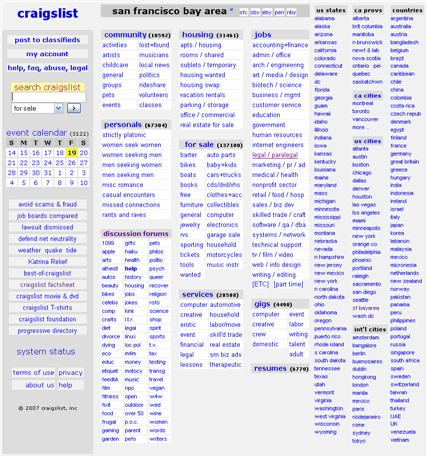The craigslist Anomaly
Posted 27 January 2007
craigslist is a fascinating anomaly in the world of large-scale web sites. Take a look at these numbers, as published by Craigslist with October 2006 data from Yahoo! and Alexa:
| Rank | Employees | Company |
| (page views) | ||
| 1 | 10,000 | Yahoo! |
| 2 | 90,000 | TimeWarner |
| 3 | 10,000 | |
| 4 | 70,000 | Microsoft |
| 5 | 50,000 | News Corp |
| 6 | 12,000 | eBay |
| 7 | 23 | craigslist |
| 8 | 25,000 | BBC |
| 9 | 130,000 | Disney |
| 10 | 12,000 | Amazon |
That’s not a typo for the number of employees at craigslist—while the other top-10 sites have more than 10,000 employees (most of them far more), craigslist has 23.
Now obviously this isn’t entirely fair, since most of these other businesses run much more than just a web site. But nevertheless, it is an impressive statistic.
Another thing that makes craigslist such an anomaly is its design, which can politely be called austere or minimalist—or more directly, just plain ugly. Google is perhaps the closest, but even it is relatively beautiful, and all the others on the list seem to be operating in a different design universe.

It would not be hard to create a much more attractive version of craigslist, and there’s plenty of features that could be added. But why would craigslist do so? They have a very successful product, and it is not very vulnerable to attack. If a startup built a “better craigslist,” could they get traction? It would be tough, since the size of the user base is much more important than features an aesthetics.
What lessons can we draw from this anomaly? I’d propose the following:
- Providing a valuable service for free can attract a large and loyal audience. This is one case where the first-mover advantage is tremendous. You want to post your ads where lots of people will see them, which makes it hard for a new site to gain traction.
- Design is secondary to functionality, at least for sites that are delivering a simple utility, rather than entertainment. When compared to a newspaper’s classified ad section, craigslist isn’t especially ugly.
- User-generated content can form virtually the entire content of a very large site, if you choose your domain carefully.
- With user-generated content and little effort expended on design and new features, it is possible to have a lot of traffic with a very small staff.
Replicating this success is not, of course, something that any new site could rationally aspire to do. Perhaps the central reason for craigslist’s great success is that they took a function that was being done offline (classified ads) but could be better done online, and translated it quite simply to to online world. Their goals were modest, and they weren’t trying to build a huge franchise—they were simply trying to solve a problem. Ironically, this led to a huge and powerful franchise.
Today, alas, there’s not many widely performed offline tasks for which there aren’t already half a dozen online alternatives.
